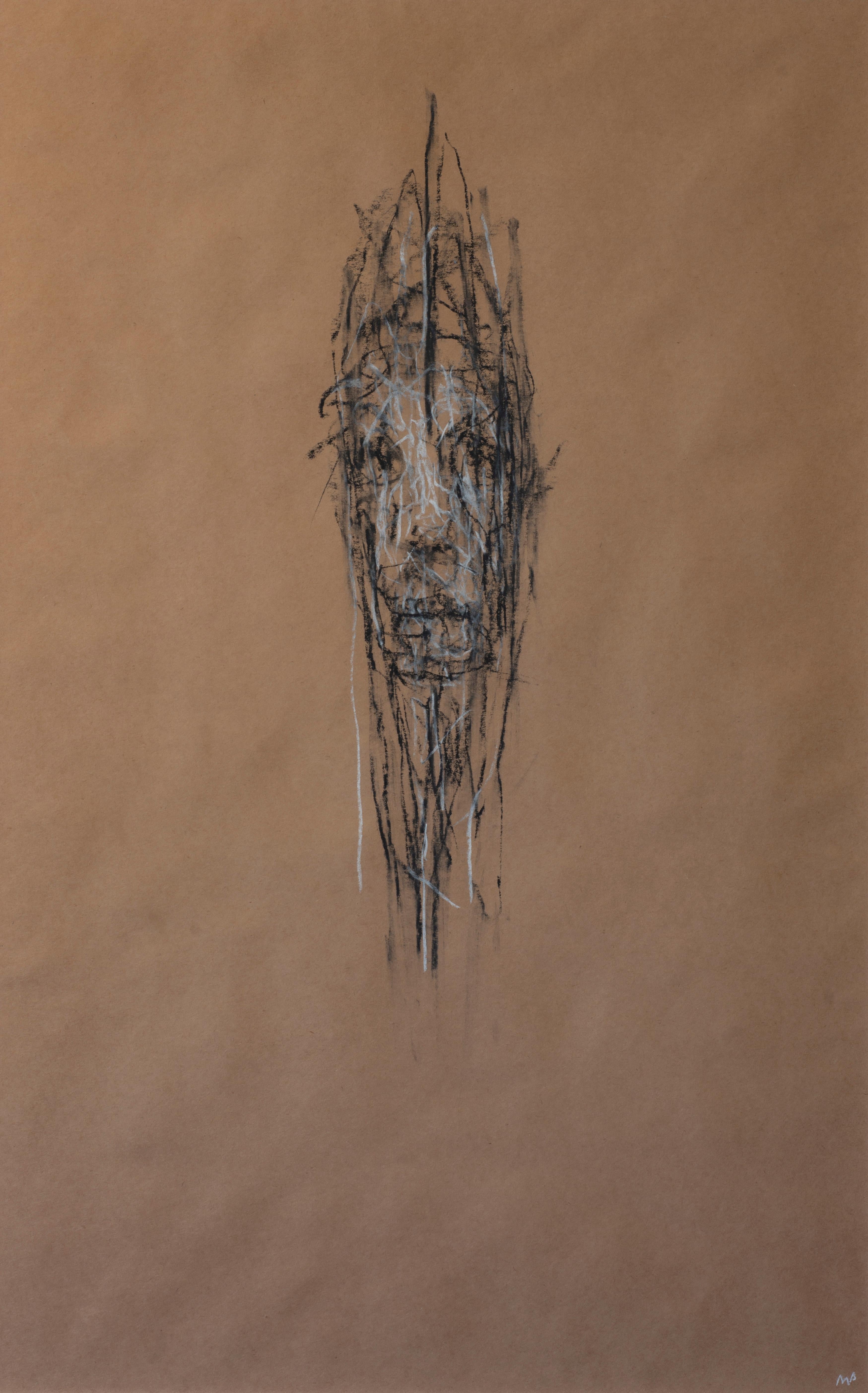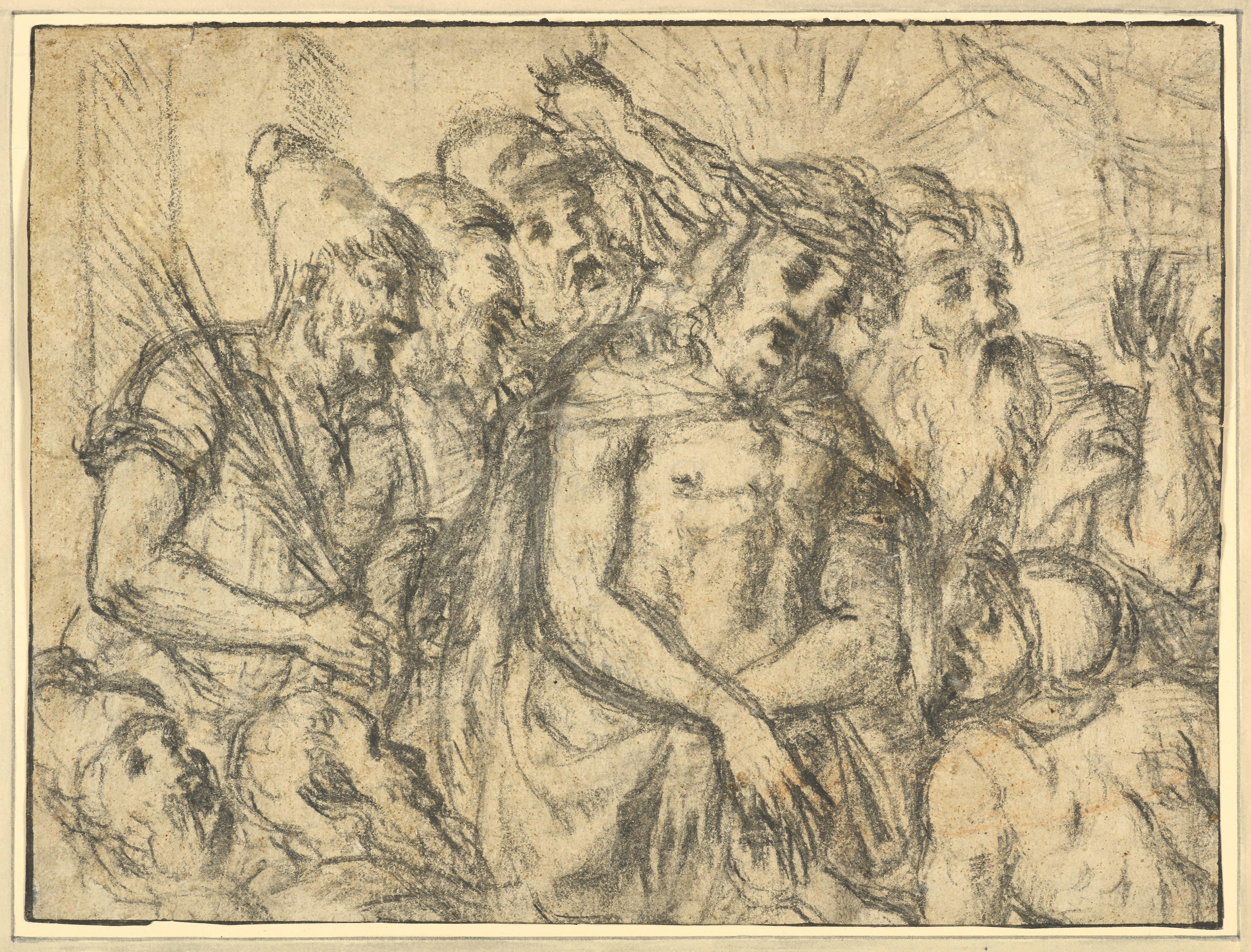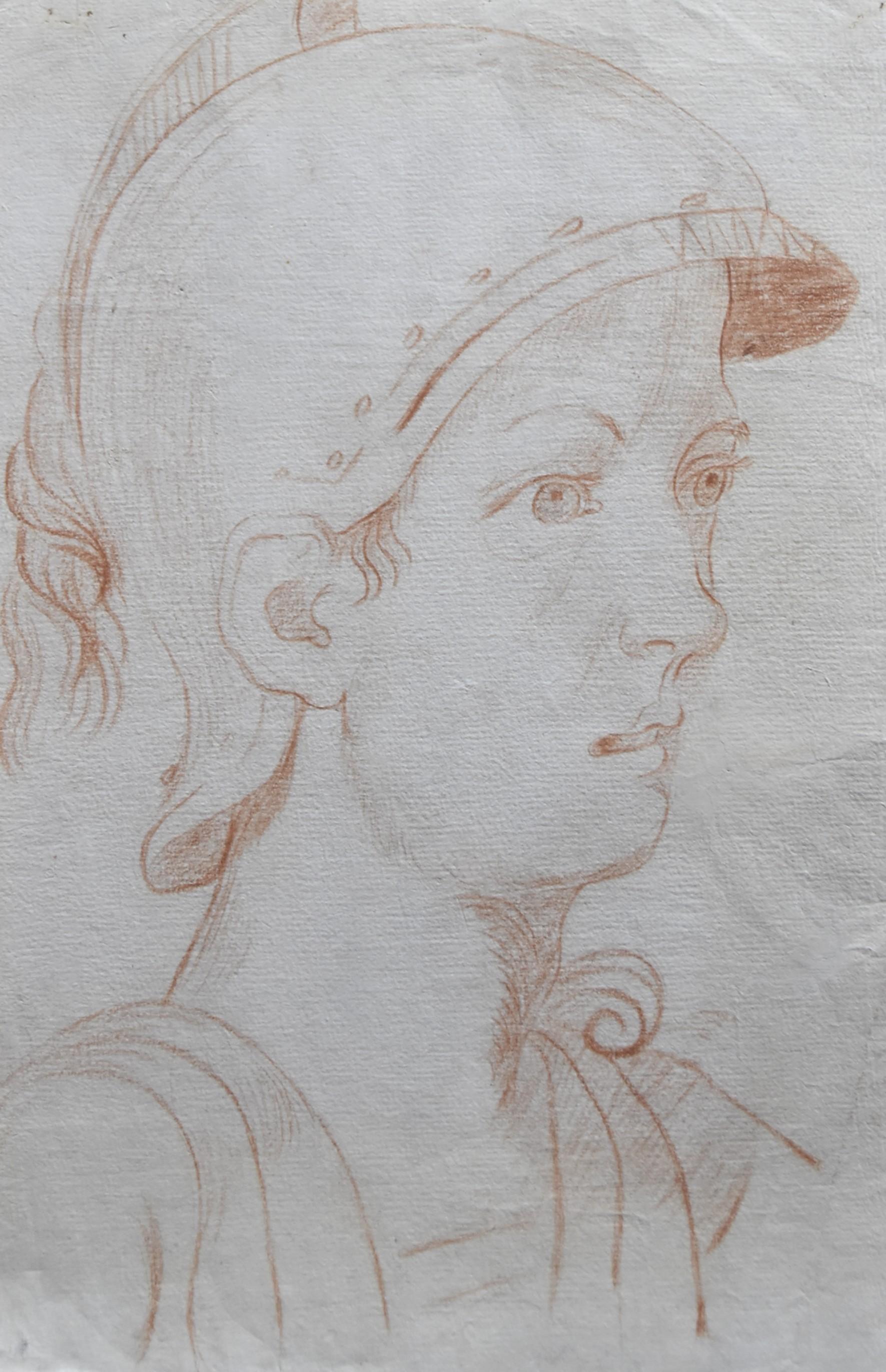Items Similar to Dancer - 20th Century British/Indian abstract drawing by Mary Krishna
Want more images or videos?
Request additional images or videos from the seller
Mary KrishnaDancer - 20th Century British/Indian abstract drawing by Mary Krishnacirca 1960
circa 1960
About the Item
MARY KRISHNA
(1909-1968)
Dancer I
Signed l.l.: Mary Krishna
Black and white chalks on grey paper
Unframed, in conservation mount
22.5 by 14.5 cm., 22 ¾ by 5 ¾ in.
(mount size 42.5 by 32.5 cm., 16 ¾ by 12 ¾ in.0
Mary Krishna (nee Oldfield) studied at the Royal College of Arts in the late 1920s. It was there that she met her husband, the Indian artist Roop Krishna. They moved to his native Punjab where they continued their studies at the Lahore School of Fine Arts under the Indian watercolour painter Abanindranath Tagore. They were members of a group of early 20th century artists in India who experimented with Western influences, blending them with traditional Indian techniques and construction. Her subjects included gods, animals and often dancers depicted in an animated or spinning vortex of movement. They moved permanently to London in 1946 and she exhibited regularly at the Royal Academy between 1955 and 1967.
- Creator:Mary Krishna (1909 - 1968, British)
- Creation Year:circa 1960
- Dimensions:Height: 8.86 in (22.5 cm)Width: 5.71 in (14.5 cm)
- Medium:
- Movement & Style:
- Period:
- Condition:
- Gallery Location:London, GB
- Reference Number:

About the Seller
4.9
Vetted Seller
These experienced sellers undergo a comprehensive evaluation by our team of in-house experts.
Established in 2004
1stDibs seller since 2018
50 sales on 1stDibs
Typical response time: 1 to 2 days
- ShippingRetrieving quote...Ships From: Banbury, United Kingdom
- Return PolicyA return for this item may be initiated within 14 days of delivery.
More From This SellerView All
- The Model - 1930s mural design for Eltham Palace by Harry Carleton AttwoodLocated in London, GBHARRY CARLETON ATTWOOD (1907-1985) The Model - Design for Eltham Palace Coloured chalks, arched top Framed 21 by 13 cm., 8 ¼ by 5 in. (frame size 39.5 by 31.5 cm., 15 ½ by 12 ½ in...Category
1930s Art Deco Figurative Drawings and Watercolors
MaterialsChalk
- Fruit Gatherers - 1930s Design for a mural by Harry Carleton AttwoodLocated in London, GBHARRY CARLETON ATTWOOD (1907-1985) Fruit Gatherers - Design for Eltham Palace Chalks Framed 23 by 13 cm., 9 by 5 in. (frame size 39.5 by 31.5 cm., 15 ½ by 12 ½ in.) Attwood was b...Category
1930s Art Deco Figurative Drawings and Watercolors
MaterialsChalk
- 20th Century British drawing of a Girl Reading by Carolyn SergeantBy Carolyn SergeantLocated in London, GBCAROLYN SERGEANT (1937-2018) Girl Reading Pencil and black chalk, heightened with white, unframed 40.5 by 28 cm., 16 by 11 in. (mount size 57 by 43 cm., 22 ½ by 17 in.) Carolyn Cann studied at Wimbledon School of Art (1955-59) and at the Royal Academy Schools (1959-62) where she was a Silver Medallist. At the Royal Academy Schools she met and later married her fellow student, John Sergeant. She had several one-man exhibitions in London, at the Fine Art Society, Colnaghi, Hazlitt, Gooden & Fox, the Waterhouse Gallery and Waterman Gallery. She also showed at the Leicester Galleries, Roland, Browse and Delbanco and elsewhere. In 1983 John and Carolyn bought an old run down farm house near Builth Wells in Powys, mid Wales. The house needed such extensive renovation that it took many years to complete. After their two sons...Category
1960s Realist Figurative Drawings and Watercolors
MaterialsChalk
- Plenty - 1930s British Art Deco design for a Mural by Harry Carleton AttwoodLocated in London, GBHARRY CARLETON ATTWOOD (1907-1985) Plenty - Design for Eltham Palace Chalks Framed 20.5 by 12 cm., 8 by 4 ¾ in. (frame size 39.5 by 31.5 cm., 15 ½ by 12 ½ in.) Attwood was born i...Category
1930s Art Deco Figurative Drawings and Watercolors
MaterialsChalk
- Going to Mass, Spain - 20th Century British drawing by Robert Sargent AustinBy Robert Sargent Austin, R.A., P.R.E., P.R.W.S.Located in London, GBROBERT SARGENT AUSTIN, RA, PRWS, RE (1895-1973) Going to Mass, Spain Black, brown and white chalks on grey paper Framed 49 by 38 cm., 19 ¼ by 15 in. (frame size 73 by 60.5 cm., 2...Category
Mid-20th Century Realist Figurative Drawings and Watercolors
MaterialsChalk
- Spring - Chalk design drawing for a Minton plaque by Herbert Wilson FosterBy Herbert Wilson FosterLocated in London, GBHERBERT WILSON FOSTER (1846-1929) Spring Inscribed with title beneath the mount Chalk, circular Framed Diameter 42 cm., 16 ½ in. (frame size 61 by 58 cm., 24 by 22 ¾ in.) Herbert Wilson Foster was born in Endon, Staffordshire. He attended Hanley School of Art before continuing his studies in London, Belgium and France. His paintings of rural and domestic subjects were exhibited at the Royal Academy between 1873 and 1899. In 1893 he accepted a teaching position at the Nottingham School of Art, where his pupils included Laura Knight and Harold Knight. Works by him are in the collections of the Minton archives; the Wisbech & Fenland Museum; Leicester Art Gallery; Rushcliffe Council and Nottingham Castle Museum. In addition to his work as a painter he worked as a porcelain painter, working at one point on the tile panels in the Victoria & Albert Museum. He is known to have worked at Mintons from 1872 where he specialized in portraits of contemporary personalities, including members of the Royal Family. This head of a girl was probably intended for a painted ceramic wall charger...Category
1870s Realist Figurative Drawings and Watercolors
MaterialsPencil, Chalk
You May Also Like
- HUMAN ATMOSPHERE Retro-study 5 - contemporary artwork, emerging artistBy Michael PembertonLocated in London, GBIn this exhibition, British painter Michael Pemberton (b. 1974) suggests we each have a personal HUMAN ATMOSPHERE. An ether where we truly exist, unseen by the naked eye but as real ...Category
21st Century and Contemporary Abstract Figurative Drawings and Watercolors
MaterialsChalk, Charcoal
- HUMAN ATMOSPHERE Retro-study 1 - contemporary artwork, emerging artistBy Michael PembertonLocated in London, GBIn this exhibition, British painter Michael Pemberton (b. 1974) suggests we each have a personal HUMAN ATMOSPHERE. An ether where we truly exist, unseen by the naked eye but as real ...Category
21st Century and Contemporary Abstract Figurative Drawings and Watercolors
MaterialsChalk, Charcoal
- Abstract Expressionist CoBrA Style Figure. Chalk on Card.Located in Cotignac, FRAbstract expressionist CoBrA style chalk on paper of a human figure attributed to French artist, A Nuchy. The work is unsigned but was acquired along with ...Category
1970s Abstract Expressionist Figurative Drawings and Watercolors
MaterialsChalk, Cardboard
- French Contemporary Art by Francine Ledieu - FardeauxLocated in Paris, IDFPencil, black & brown chalk on paper Francine Ledieu is a French artist born in 1931 who lives and works in Paris, France. In the 50s, she was a student of Maurice Rocher who specia...Category
1960s Abstract Figurative Drawings and Watercolors
MaterialsPaper, Pencil, Chalk
- Christ before Herod, a drawing from the School of TitianLocated in PARIS, FRThis vigorous drawing is clearly inspired by the numerous compositions on the Ecce Homo theme which were produced by Titian and his workshop at the painter's maturity. However, the number of characters and their expressionist treatment, the many variations to Titian's paintings reveal a drawing made by an original artist, perhaps of foreign origin, belonging to the peripheral circle of the "Titian solar system”, as described by the art historian Enrico Maria del Pozzolo. 1. Titian, the leading artist of 16th century Venetian painting and his botteghe Tiziano Vecelli (or Vecellio), known as Titian, was born between 1489 and 1490 in Pieve di Cadore in the Veneto region of Italy into a wealthy family of soldiers and lawyers. At the age of 15, he joined the studio of Giovanni Bellini, where he became friend with Giorgione, ten years his senior. Giorgione introduced him to a new pictorial style in which forms are defined by colour and pictorial substance, freeing himself from the meticulous underlying drawings characteristic of Bellini's painting. Titian became the official painter of the Republic of Venice upon Bellini's death in 1516. In 1518, the completion of his Assumption for the church of Santa Maria Gloriosa dei Frari in Venice established his reputation as the leading painter of the Venetian school: throughout his career, Titian had a considerable impact on other artists of his time, whether they were direct collaborators, occasional contributors, or other artists under his influence. Considered one of the greatest portraitists of his time, his fame spread throughout Europe and he became the official painter of the greatest European families: the Gonzagas, the Farneses (Alessandro Farnese, of whom he executed several portraits, was elected pope in 1534 under the name of Paul III), the Habsburgs (he went to Augsburg in 1548 to paint the portrait of Charles V and King Philip II of Spain, his successor, later became the artist's main patron). As Titian almost reached the age of 90 years, he saw during his lifetime the death of many of his loved ones (his wife Cecilia, his brother Francesco and his son Orazio). A pathetic feeling appears in his late artworks, such as his famous Pieta, his last work intended to decorate his tomb which remained unfinished. Titian's success was also based on the establishment of a large and versatile workshop, which, alongside the traditional assistance in the production of certain paintings, ensured the publication of numerous woodcuts, allowing the master's works to be widely distributed. Long ignored by art historians, the individual stories of these various collaborators, the organisation of this workshop and the interactions of the collaborators with the master are at the heart of contemporary studies on the artist. 2. A complex composition with expressionist overtones Executed with great virtuosity in black chalk, the composition of our drawing is complex, even slightly confused and probably reflects several phases of execution, if not several hands. The scene is organised around the characters of Christ and an executioner wearing a Phrygian cap. Christ is presented at mid-body, slightly at an angle, his torso bare, his shoulders draped in a cloak, his hands clasped together and probably bound. His head, as if weighed down by the crown of thorns, is slightly bent forward. The eyes and mouth are hollowed out by the black chalk to better express his sorrow. The man wearing a Phrygian cap holds a whip in his right hand, while his left hand, barely outlined, seems to be pulling aside Christ's tunic as if he were about to scourge him. Two other men, who may have been added at a later stage, occupy the space between the executioner and Christ. One is depicted in profile, while the one behind Christ appears to be wearing a military helmet. In an indistinct gesture, his left arm is raised as if to strike Christ. Slightly behind Jesus on his left side, appears a bearded old man wearing a turban. With his left arm raised, he holds out the palm of his hand in a gesture of amazement. His face is finely executed and contrasts with the hand depicted in a rather crude manner. This character may also have been added at a later stage, as he does not fit in perfectly behind the group formed by Jesus and his executioner. This frieze is completed in the left foreground by two additional figures depicted in three-quarter view. Soberly sketched but with great fluidity, only their heads emerge, as if Christ and his executioners were situated on a pedestal above a large crowd. Finally, on the right-hand side of the composition, a second helmeted soldier is depicted. His musculature can be seen under his armour while he stares intently at Christ. He is smaller than the other figures, even though he appears in the front row, revealing a certain clumsiness on the part of the artist. 3. Ecce Homo, one of Titian’s favourite subjects in his twilight years In 1543, Titian tackled the theme of the Ecce Homo in a masterly composition now in the Kunsthistorisches Museum in Vienna. Christ is presented by Pilate, dressed in an antique costume, at the top of a staircase, in a large, highly architectural setting animated by a crowd of characters. The title of the painting refers to a passage from the Gospel of St John (19, 1-5): “Then Pilate took Jesus and had him flogged. The soldiers twisted together a crown of thorns and put it on his head. They clothed him in a purple robe and went up to him again and again, saying, “Hail, king of the Jews!” And they slapped him in the face. Once more Pilate came out and said to the Jews gathered there, “Look, I am bringing him out to you to let you know that I find no basis for a charge against him.” When Jesus came out wearing the crown of thorns and the purple robe, Pilate said to them, “Here is the man!” From the 1540s onwards, Titian and his workshop repeatedly depicted the Christ of Sorrows for their principal patrons. In these paintings, Titian returned to the half-body format that he had practically abandoned since 1520 and refocused the composition (compared to the large 1543 Ecce Homo) on the figure of Christ, who is depicted alone or accompanied by a few figures. With his eyes lowered and his head slightly bowed, Titian's Christ seems calmly resigned to his fate. Powerless and submissive, he arouses deep pathos from the viewer. The tondo in the Louvre Museum shows Christ in a position very similar to that of our drawing, a position that will be found in most of Titian's Ecce Homo. To his right stands a helmeted soldier who seems to be baring his shoulder and to his left a servant of Pilate wearing a Phrygian cap. These two figures are reminiscent of the soldier in the lower right corner and the executioner in the left most part of our drawing. Various versions were executed by Titian and his workshop until the late 1560s, and the version that seems closest to the right-hand side of our drawing is the one in the Prado Museum. Although of uneven quality, it is interesting to note the gesture of Pilate's hand, holding out the palm of his left hand towards the viewer, as if to distance himself from the decision that the crowd will make. Recent X-rays of the painting have shown that the executioner on the right, depicted from behind, was originally depicted in profile (as in our drawing), and that the other two figures (Pilate on the left of Christ and a servant wearing a Phrygian cap on his right) were added later. The painting was then organised around the diagonal that crosses the canvas from left to right, emphasised by the light coming from the window, and centred on the exchange of glances between Christ and the executioner on his left. The profile of the old man in the foreground on the left could be inspired by that of the elderly Titian as it appears repeatedly in the painter's late artworks, such as the Madonna of Mercy in the Palatine Gallery. 4. A deeply original drawing, at the risk of confusion We saw in the last paragraph the various borrowings from Titian's depictions of the Ecce Homo that can be found in this drawing: the position of Christ, the presence of executioners wearing Phrygian caps and of helmeted soldiers, one of whom is looking at Christ in a position that evokes the repentance visible with X-ray in the Madrid painting...Category
16th Century Old Masters Figurative Drawings and Watercolors
MaterialsChalk
- Italian School 18th century, An Ancient soldier in profile, red chalk on paperLocated in Paris, FRItalian School 18th Century An Ancient soldier in profile, red chalk on paper 35 x 23.5 cm in good condition, traces of folds in the lower right corner Framed : 46.5 x 35.5 cm This...Category
1750s Baroque Portrait Drawings and Watercolors
MaterialsChalk
Recently Viewed
View AllMore Ways To Browse
British 20th Century Artists
Mary Early
Mary I
Mary Gray
Early 20th Century British Artists
Western Indian Paintings
Indian Western Art
Western Indian
Western Indian Art Painting
Vintage Dance Moves
Indian Dancer
Indian Dance
Dance India
Vintage Dancer 1920s
Indian Dance Painting
Royal Indian Vintage
Krishna Painting
Indian Art Krishna





